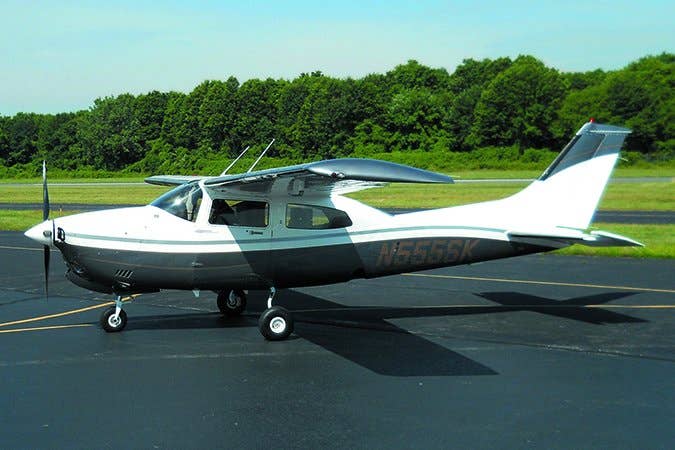Buying A Used Aircraft: Cessna 210 Centurion
The Cessna 210 Centurion offers good range and endurance, loading flexibility and go-places cruise speed. With six seats, the retractable-gear 210 is an appealing step-up airplane to those who got…

Cessna 210 Centurion. Photo credit: Aviation Consumer
The Cessna 210 Centurion offers good range and endurance, loading flexibility and go-places cruise speed. With six seats, the retractable-gear 210 is an appealing step-up airplane to those who got their feet in a 100-series Cessna. But buyers should pick one that’s been well maintained, and learn to fly it right—Centurions are not airplanes for tight maintenance budgets or careless engine management.
Cessna Centurion: Sophisticated and Sought-After
Hitting the ramps around 1960, the early Cessna 210s were little more than retractable 182s (they even had wing struts) that eventually evolved into three basic types: the normally aspirated, turbocharged and pressurized versions. In 1967, Cessna replaced the strut-based wing with a cantilevered design. Normally aspirated models were powered by the 285-HP Continental IO-520-J, and by the 1970 model, the 210 had extra baggage space, two additional seats and a 3400-pound gross weight. The next model year saw a boost in takeoff horsepower to 300 HP. Only one additional model—the 210R—would come out before production ended around 1986. It had a 300-HP Continental TSIO-520-CE powerplant with a 1600-hour TBO.
Any potential Centurion owner should be aware of main systems and landing gear maintenance history, and systems design varies widely among the fleet. Early on (1972) the landing gear system was reworked to a simpler (although not without required upkeep) electrohydraulic system. Seven years later, the main gear doors were eliminated, which makes for simpler upkeep. But the airplane doesn’t exactly have stone-simple systems, even if they might make the airplane safer. Cessna pioneered electrical redundancy in piston singles with optional dual alternators and vacuum pumps, which became standard with 1983 models. These days, electronic flight instrument upgrades provide even more backup and redundancy, with some owners opting to remove the vacuum system altogether. Plan on cruise speeds in the 170-knots true range, and impressive useful loads that can exceed a half ton.
Cessna 210 Handling and Safety
Based on our extensive experience flying and owning 210s, it’s fair to say the airplane is stable in pitch and roll, although precise pitch trim management is a must. Get sloppy with speed management and hitting the target speeds for approach and landing will be very difficult, although a high gear extension speed helps slow down earlier than other models. Still, when flown correctly (and when equipped with a good autopilot) the Centurion is an excellent IFR platform—perhaps one of the best available among the competition. But don’t skimp on training.
Based on the NTSB reports we’ve researched, fuel and improper landing gear maintenance are the most common caution flags in accidents involving the Cessna 210. A review of the 100 most recent accidents found 20 percent to be fuel related, 17 percent to be engine/mechanical and 14 percent to be gear-up landings. Bottom line? Keep any Centurion well maintained by a shop that knows the breed, and bring your A-game to the cockpit every time. High-flying turbocharged and pressurized models deserve extra transition training focused on high-altitude ops.
A consistent point from owners is the high cost of owning a 210. Annual inspections can run around $3000 on the low end to $10,000 or more depending on the overall condition and engine times. Turbocharged and pressurized models will obviously be more complex—and pricey. There are FAA ADs in place for airframe issues on a big chunk of Centurion fleet, so shop wisely, and pick a model with good records and a solid maintenance history.
The main gear doors have been an ongoing area for upkeep for years, along with other gear-related problems including power packs and rigging issues, plus the long-term service of basic components like rod ends and other mechanical parts can take a toll.
“It was a tough choice and I passed on some good competitor-brand airplanes before buying my mostly refurbished pressurized 210,” one new owner told us. The Bonanza 36 and Piper Saratoga/Lance and even the Piper Malibu/Mirage might be on the list for comparison shopping the Centurion line.
Cessna 210 Price
Centurion prices have been steadily increasing. According to the current Aircraft Bluebook, a 1967 210G has an average retail price of $70,000. A 1980 turbocharged T210N is $180,000, although we’ve seen restored models sell well north of $200,000. A late-model pressurized P210R could easily fetch $400,000, when upgraded. Plan to spend a big premium for any Centurion with low engine time, new avionics and a stellar maintenance history.
For a deeper dive on the Cessna 210 Centurion, head to Aviation Consumer and the Used Aircraft Guide, where you’ll get a detailed model history, historical resale values, recent FAA ADs, competing model speed/payload/price comparisons and a detailed current NTSB accident scan summary.






